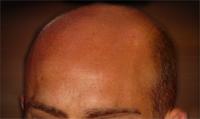 Initiating the same process that happens after wound healing could spout new hairs.Addstyle
Initiating the same process that happens after wound healing could spout new hairs.AddstyleSkin may have the capacity to regenerate lost hair follicles from within, according to a new discovery that could yield better treatments for baldness or abnormal hair growth. Researchers in the United States have found that, when skin is wounded, epidermal cells can respond by assuming the properties of stem cells that generate hair follicles and growing new hair.
That's what happens in mice, report George Cotsarelis and his team at the University of Pennsylvania School of Medicine in Philadelphia. If the same is true of human skin, the research raises the possibility that older men with established baldness could be successfully restored to their former hirsute glory.
The researchers removed patches of skin from mice and studied the wounds as they healed during the ensuing weeks. As they report in this week's Nature1, cells that had not initially been associated with hair follicles began to express genes found in the stem cells that give rise to follicles during development. Hair growth occurred regardless of the mouse's age, the researchers report, although the new hairs did not contain pigment.
The process happened naturally after wounding. But the researchers found they could boost the effect by using mice that had been genetically engineered to produce higher levels of proteins that activate the genetic pathway underpinning the transformation to follicle stem cells. These mice responded to wounding by producing twice the density of hairs found in the coats of normal, untreated mice.
Cotsarelis and his colleagues now hope to mimic this for human skin. They envisage a treatment similar to the 'dermabrasion' used to treat skin scarred by teenage acne — a process that uses gentle damage to encourage wound healing processes — combined with a topical cream to activate the genetic pathway.
"It's all preliminary at the moment," says Cotsarelis, who has helped to set up a company, Follica, that will attempt to bring the idea to market. "If it all went perfectly then possibly in two to three years we would have a product, but that's very optimistic."
Hair today, gone tomorrow
Previously, it was generally accepted that hair follicles cannot be regrown after a person reaches adulthood, meaning that once they are lost — through skin damage or the baldness-promoting effects of some hormones — they are gone forever.
Although experts first suggested that follicle regrowth might be possible half a century ago, no one had ever proved the cells' regenerative capability.
The fact that it occurs as a result of skin damage might explain why the process has taken so long to find and verify, Cotsarelis reflects. "Most people studying skin wounding don't pay a lot of attention to hair follicles," he says. "They view wound closure as the end-point."
The discovery opens up new insights into how skin functions. The research "provides convincing evidence that the skin has remarkable powers of regeneration, not just repair," says Desmond Tobin, a cell biologist at the University of Bradford, UK.
But baldness treatments will be the inevitable focus of further research in this area.
No more toupees
Current baldness treatments include minoxidil, which expands blood vessels in the scalp; anti-androgens, which attempt to minimize the ravages of testosterone and its related hormones; and hair-follicle transplants.
ADVERTISEMENT
Using these existing treatments is "a long and slow process", says Carol Michaelides, a consultant at the Philip Kingsley Trichological Clinic in London. What's more, the chances of success diminish both with age and with the degree of hair thinning. "The accepted baseline is 30 hairs per square centimetre," says Michaelides. A healthy head will boast many hundreds of hairs in the same area of scalp.
Another area of research currently being pursued is the idea of transplanting follicular stem cells into the scalp from another source, although this approach is also several years from the clinic, Michaelides says. But if the scalp can be induced to create its own new follicles, it would be "a huge step forward", she adds.
Visit our owncellscouldbeat_bald.html">newsblog to read and post comments about this story.
